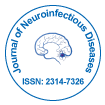The Impact of Global Hyperperfusion Following Endovascular Thrombectomy on Prognosis in Acute Ischemic Stroke
Received: 01-May-2024 / Manuscript No. JNID-24-137516 / Editor assigned: 03-May-2024 / PreQC No. JNID-24-137516 / Reviewed: 17-May-2024 / QC No. JNID-24-137516 / Revised: 22-May-2024 / Manuscript No. JNID-24-137516 / Published Date: 29-May-2024 DOI: 10.4172/2314-7326.1000508 QI No. / JNID-24-137516
Abstract
Acute ischemic stroke remains a significant cause of morbidity and mortality worldwide. Endovascular thrombectomy has emerged as a primary treatment modality, offering improved outcomes for select patients. However, recent studies have highlighted the potential detrimental effects of global hyperperfusion following successful thrombectomy, complicating prognostic assessments. This article reviews the current literature to elucidate the association between global hyperperfusion and prognosis post-thrombectomy in acute ischemic stroke patients. We discuss the mechanisms underlying hyperperfusion injury, the clinical implications, and potential strategies for mitigating its adverse effects
Keywords
Acute ischemic stroke; Endovascular thrombectomy; Hyperperfusion; Prognosis; neuroimaging; Clinical outcomes
Introduction
Acute ischemic stroke represents a major healthcare challenge globally, with significant morbidity and mortality rates. The advent of endovascular thrombectomy has revolutionized acute stroke management, offering a promising therapeutic option for eligible patients [1]. However, despite its efficacy in achieving vessel recanalization and improving perfusion, endovascular thrombectomy may inadvertently lead to global hyperperfusion, a phenomenon associated with adverse clinical outcomes. This article aims to explore the relationship between global hyperperfusion following endovascular thrombectomy and prognosis in acute ischemic stroke [2]. Global hyperperfusion refers to a state of increased cerebral blood flow exceeding metabolic demands, leading to cerebral edema, hemorrhage, and ultimately, neuronal injury. Following successful recanalization of the occluded vessel, reperfusion injury may occur due to the restoration of blood flow to previously ischemic tissue [3]. The abrupt increase in perfusion pressure can overwhelm the compromised blood-brain barrier, resulting in extravasation of fluid and blood constituents into the brain parenchyma. Additionally, dysregulation of cerebral auto regulation mechanisms may contribute to hyperperfusion, exacerbating tissue damage.
Discussion
Recent studies have demonstrated a significant association between global hyperperfusion and adverse clinical outcomes in patients undergoing endovascular thrombectomy for acute ischemic stroke. Neuroimaging modalities, including perfusion-weighted imaging and CT perfusion, have been instrumental in identifying hyperperfusion patterns post-thrombectomy [4]. These imaging findings correlate with poor prognosis markers such as hemorrhagic transformation, cerebral edema, and neurological deterioration. Furthermore, hyperperfusion syndrome, characterized by headache, seizures, and focal neurological deficits, may manifest in susceptible individuals, further complicating post-thrombectomy management. The presence of global hyperperfusion following endovascular thrombectomy portends a poorer prognosis for acute ischemic stroke patients. Increased risk of hemorrhagic transformation, malignant cerebral edema, and long-term disability has been observed in individuals experiencing hyperperfusion post-thrombectomy [5]. The severity and duration of hyperperfusion, as well as underlying comorbidities such as hypertension and diabetes, influence the prognostic trajectory. Timely recognition of hyperperfusion-related complications is crucial for risk stratification and targeted intervention to optimize outcomes [6]. Management of global hyperperfusion following endovascular thrombectomy necessitates a multifaceted approach aimed at mitigating cerebral edema and reducing the risk of hemorrhagic transformation. Tight blood pressure control, avoidance of hyperglycemia, and judicious fluid management are cornerstone strategies in the acute phase. Additionally, neuroprotective agents such as osmotic diuretics and corticosteroids may be considered in selected cases to alleviate cerebral edema and minimize secondary brain injury [7]. Close monitoring of neurological status and serial neuroimaging facilitate early detection of hyperperfusion-related complications, guiding therapeutic interventions. Future research endeavors should focus on elucidating the underlying mechanisms driving global hyperperfusion and its impact on long-term functional outcomes in acute ischemic stroke patients [8]. Advanced neuroimaging techniques, including functional MRI and diffusion tensor imaging, may provide valuable insights into the dynamics of cerebral perfusion and tissue viability post-thrombectomy. Furthermore, prospective multicenter studies are warranted to develop standardized protocols for the management of hyperperfusion-related complications and optimize post-thrombectomy care algorithms [9].
Conclusion
Global hyperperfusion following endovascular thrombectomy represents a double-edged sword in the management of acute ischemic stroke. While successful recanalization restores cerebral perfusion and salvages ischemic tissue, the ensuing hyperperfusion may precipitate neurovascular complications and worsen clinical outcomes. Recognizing the clinical implications of hyperperfusion syndrome and its prognostic significance is paramount for clinicians involved in acute stroke care. By implementing tailored management strategies and advancing our understanding of hyperperfusion pathophysiology, we can strive to improve outcomes and enhance the quality of life for acute ischemic stroke survivors.
Acknowledgement
None
Conflict of Interest
None
References
- Rao NP, Shailaja U, Mallika KJ, Desai SS, Debnath P (2012)IJRiAP 3: 1-5.
- Aniket P, Pallavi D, Aziz A, Avinash K, Vikas S (2017)JAIMS 2: 11-18.
- Gaikwad A (2011)Jam 12: 2-7.
- Singh (2016). Jam 24: 4-9.
- Rathi R, Rathi B (2017)J Ind Sys Med 5: 91.
- Ismaili K, Hall M, Donner C, Thomas D, Vermeylen D, et al. (2003)Am J Obstet Gynecol 188: 242-246.
- Coplen DE, Austin PF, Yan Y, Blanco VM, Dicke JM (2006)J Urol 176: 724-727.
- Grignon A, Filion R, Filiatrault D, Robitaille P, Homsy Y, et al. (1986)Radio 160: 645-647.
- Ocheke IE, Antwi S, Gajjar P, McCulloch MI, Nourse P (2014)Arab J Nephro Tran 7: 33-36.
- Capello SA, Kogan BA, Giorgi LJ (2005)J Urol 174: 1425-1428.
, , Crossref
,
, ,
, ,
,
,
,
,
,
,
Citation: Douaud J (2024) The Impact of Global Hyperperfusion FollowingEndovascular Thrombectomy on Prognosis in Acute Ischemic Stroke. J NeuroinfectDis 15: 508. DOI: 10.4172/2314-7326.1000508
Copyright: © 2024 Douaud J. This is an open-access article distributed under theterms of the Creative Commons Attribution License, which permits unrestricteduse, distribution, and reproduction in any medium, provided the original author andsource are credited.
Share This Article
Recommended Journals
Open 91桃色 Journals
Article Tools
Article Usage
- Total views: 504
- [From(publication date): 0-2024 - May 08, 2025]
- Breakdown by view type
- HTML page views: 318
- PDF downloads: 186
